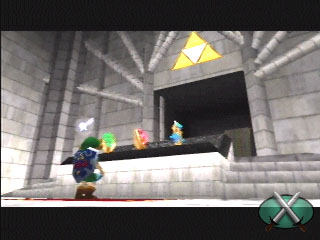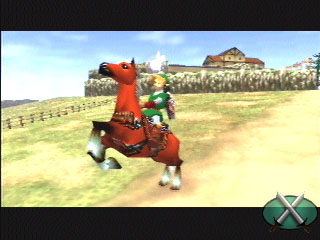 |
The Legend of Zelda: The Ocarina of Time - Review |
 |
A Musical Adventure
By: Jake Alley
| Review Breakdown |
| Battle System |
10 |
| Interface |
10 |
| Music/Sound |
9 |
| Originality |
7 |
| Plot |
6 |
| Localization |
6 |
| Replay Value |
6 |
| Visuals |
9 |
| Difficulty |
Easy |
| Time to Complete |
10-40 hours
|
|
| Overall |
 |
| Criteria
|
Shigeru Miyamoto has a gift. While other developers can create wonderful games,
he has repeatedly created and refined new genres. For this reason, any title he has a hand in is
eagerly anticipated by the masses. The Legend of Zelda: The Ocarina of Time is one such title
which doesn't disappoint.
Like most games in the series, The Ocarina of Time's story is a remake of the original's.
This time around, the story picks up several years earlier than usual, when Ganondorf (or Ganon) is
just getting started on his reign of terror and Link is a small child. Later it becomes possible to travel
seven years into the future with the aid of the Master Sword and the titular ocarina. However, while the story
has some memorable moments and plot twists, it still doesn't measure up to most full-blooded RPGs.

|
| Shrine of the Sword
|
|
As the title would suggest, ocarinas play a major role in the game's plot. At various
junctures, Link must pull out his simple woodwind and play. Rather than make this into a simple
plot device, the developers chose to make this a part of the game. When playing, nearly every bit
of the controller can be used to play. While A and the four camera buttons generate the five basic
notes which comprise all the songs with special functions, the joystick and other buttons generate
octave shifts, allowing just about anything to be played. The game even features a way to record
such songs. Songs played on the ocarina can be used to change the weather, open doors, and even
teleport around the game's vast world. The music of the game itself is quite impressive and varied
as well. In fact, the only blemish on the game's sound is the fairy which always flies
around Link's head, warning him to "Listen!" and "Watch out!" in an annoying manner.
Graphically, The Ocarina of Time is impressive in technical terms if not detail.
While other games of it's variety feature small areas or walls of fog to hide limitations of graphical
power, The Ocarina of Time contains vast expanses of wilderness with an amazing visual range. Lakes
which take minutes to swim across can be viewed from shore to shore. Birds can be seen even when
they are but mere specks on the horizon. While one would expect low poly counts because of this,
every being in the game is actually quite well rendered, if a tad angular at times.

|
| Exploring on horseback |
|
All in all, The Ocarina of Time is a game of exploration. The rich 3D world holds
literally hundreds of secrets to be discovered. When exploring on foot grows tiresome, Link even
has a horse to ride all over the game's expansive terrain. Even after completing the game, players
can keep exploring and playing mini-games for weeks before the game grows dull.
Simply put, The Ocarina of Time is the best reason to own a Nintendo 64. With
a vast world to explore, a very innovative and intuitive interface, and the special charm Miyamoto
brings to his games, the end result is an astoundingly fun game. Bundle that with a solid story,
and a translation much better that "Dodongo dislikes smoke," and you have an instant classic.
|










